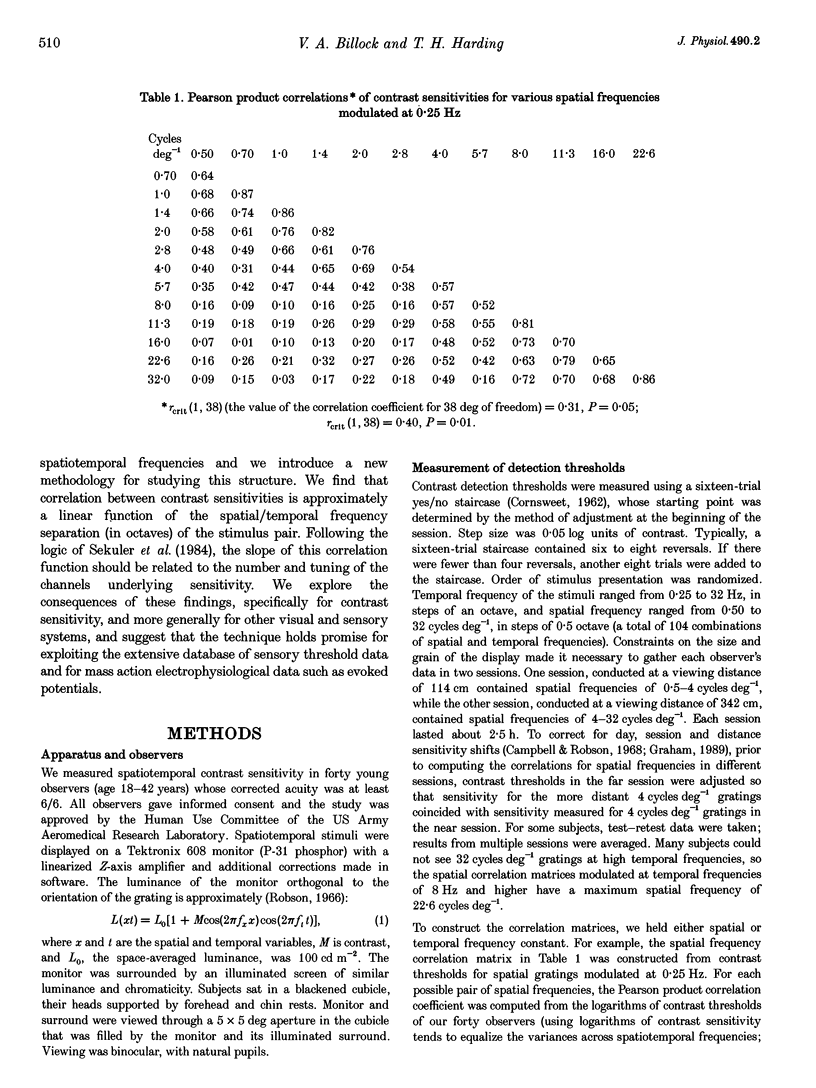Abstract
1. The statistical correlation of detection thresholds for pairs of stimuli should be higher for stimuli detected by the same mechanism than for stimuli detected by different mechanisms--a property that can be used to probe the visual mechanisms that underlie detection. 2. Correlation of contrast sensitivities for pairs of spatiotemporal stimuli is approximately a linear function of spatial or temporal frequency separation in octaves. Using the slope of this function as an index of neural processing gave results consistent with: more spatial mechanisms than temporal; more spatial mechanisms at low temporal frequencies than at high; and at least two temporal mechanisms active at spatial frequencies up to 22.6 cycles deg-1. 3. This method of analysing sensitivity data is insensitive to experimental conditions and applicable to any sensory detection task mediated by tuned channels. In addition to being applicable to psychophysical sensitivity measurements, it may also be useful in analysing some kinds of electrophysiological measurements that pool the responses from many active mechanisms (such as evoked potentials).
Full text
PDF








Selected References
These references are in PubMed. This may not be the complete list of references from this article.
- Blakemore C., Campbell F. W. On the existence of neurones in the human visual system selectively sensitive to the orientation and size of retinal images. J Physiol. 1969 Jul;203(1):237–260. doi: 10.1113/jphysiol.1969.sp008862. [DOI] [PMC free article] [PubMed] [Google Scholar]
- CORNSWEET T. N. The staircrase-method in psychophysics. Am J Psychol. 1962 Sep;75:485–491. [PubMed] [Google Scholar]
- Campbell F. W., Robson J. G. Application of Fourier analysis to the visibility of gratings. J Physiol. 1968 Aug;197(3):551–566. doi: 10.1113/jphysiol.1968.sp008574. [DOI] [PMC free article] [PubMed] [Google Scholar]
- De Valois R. L., Albrecht D. G., Thorell L. G. Spatial frequency selectivity of cells in macaque visual cortex. Vision Res. 1982;22(5):545–559. doi: 10.1016/0042-6989(82)90113-4. [DOI] [PubMed] [Google Scholar]
- Foster K. H., Gaska J. P., Nagler M., Pollen D. A. Spatial and temporal frequency selectivity of neurones in visual cortical areas V1 and V2 of the macaque monkey. J Physiol. 1985 Aug;365:331–363. doi: 10.1113/jphysiol.1985.sp015776. [DOI] [PMC free article] [PubMed] [Google Scholar]
- Hammett S. T., Smith A. T. Two temporal channels or three? A re-evaluation. Vision Res. 1992 Feb;32(2):285–291. doi: 10.1016/0042-6989(92)90139-a. [DOI] [PubMed] [Google Scholar]
- Hess R. F., Plant G. T. Temporal frequency discrimination in human vision: evidence for an additional mechanism in the low spatial and high temporal frequency region. Vision Res. 1985;25(10):1493–1500. doi: 10.1016/0042-6989(85)90227-5. [DOI] [PubMed] [Google Scholar]
- Hess R. F., Snowden R. J. Temporal properties of human visual filters: number, shapes and spatial covariation. Vision Res. 1992 Jan;32(1):47–59. doi: 10.1016/0042-6989(92)90112-v. [DOI] [PubMed] [Google Scholar]
- King-Smith P. E., Kulikowski J. J. Pattern and flicker detection analysed by subthreshold summation. J Physiol. 1975 Aug;249(3):519–548. doi: 10.1113/jphysiol.1975.sp011028. [DOI] [PMC free article] [PubMed] [Google Scholar]
- Livingstone M. S., Hubel D. H. Psychophysical evidence for separate channels for the perception of form, color, movement, and depth. J Neurosci. 1987 Nov;7(11):3416–3468. doi: 10.1523/JNEUROSCI.07-11-03416.1987. [DOI] [PMC free article] [PubMed] [Google Scholar]
- Mandler M. B., Makous W. A three channel model of temporal frequency perception. Vision Res. 1984;24(12):1881–1887. doi: 10.1016/0042-6989(84)90021-x. [DOI] [PubMed] [Google Scholar]
- Mayer M. J., Dougherty R. F., Hu L. T. A covariance structure analysis of flicker sensitivity. Vision Res. 1995 Jun;35(11):1575–1583. doi: 10.1016/0042-6989(94)00252-h. [DOI] [PubMed] [Google Scholar]
- Moulden B., Renshaw J., Mather G. Two channels for flicker in the human visual system. Perception. 1984;13(4):387–400. doi: 10.1068/p130387. [DOI] [PubMed] [Google Scholar]
- Murray I. J., Kulikowski J. J. Movement detection and spatial phase. Ophthalmic Physiol Opt. 1984;4(1):73–76. [PubMed] [Google Scholar]
- Owsley C., Sekuler R., Siemsen D. Contrast sensitivity throughout adulthood. Vision Res. 1983;23(7):689–699. doi: 10.1016/0042-6989(83)90210-9. [DOI] [PubMed] [Google Scholar]
- Peterzell D. H., Werner J. S., Kaplan P. S. Individual differences in contrast sensitivity functions: the first four months of life in humans. Vision Res. 1993 Feb;33(3):381–396. doi: 10.1016/0042-6989(93)90093-c. [DOI] [PubMed] [Google Scholar]
- Richards W. Quantifying sensory channels: generalizing colorimetry to orientation and texture, touch, and tones. Sens Processes. 1979 Sep;3(3):207–229. [PubMed] [Google Scholar]
- Sekuler R., Wilson H. R., Owsley C. Structural modeling of spatial vision. Vision Res. 1984;24(7):689–700. doi: 10.1016/0042-6989(84)90210-4. [DOI] [PubMed] [Google Scholar]
- Stromeyer C. F., 3rd, Julesz B. Spatial-frequency masking in vision: critical bands and spread of masking. J Opt Soc Am. 1972 Oct;62(10):1221–1232. doi: 10.1364/josa.62.001221. [DOI] [PubMed] [Google Scholar]
- Watson A. B., Robson J. G. Discrimination at threshold: labelled detectors in human vision. Vision Res. 1981;21(7):1115–1122. doi: 10.1016/0042-6989(81)90014-6. [DOI] [PubMed] [Google Scholar]
- Webster M. A., MacLeod D. I. Factors underlying individual differences in the color matches of normal observers. J Opt Soc Am A. 1988 Oct;5(10):1722–1735. doi: 10.1364/josaa.5.001722. [DOI] [PubMed] [Google Scholar]
- Wilson H. R., McFarlane D. K., Phillips G. C. Spatial frequency tuning of orientation selective units estimated by oblique masking. Vision Res. 1983;23(9):873–882. doi: 10.1016/0042-6989(83)90055-x. [DOI] [PubMed] [Google Scholar]
- Wilson H. R. Spatiotemporal characterization of a transient mechanism in the human visual system. Vision Res. 1980;20(5):443–452. doi: 10.1016/0042-6989(80)90035-8. [DOI] [PubMed] [Google Scholar]


